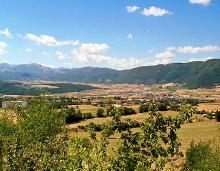 |
| Veduta panoramica di Norcia |
Sertorius was born here, as was the mother of the Emperor Vespasian and a number of families that gave senators to the Roman Empire.
After suffering devastation at the hands of the Goths, Norcia was eventually captured by the Longobards. In 480 AD. St Benedict was born here, along with his twin St Scolastica. The founding father of the first ever religious order, St Benedict is now the patron saint of Europe. Once an independent bishopric, Norcia lost its bishop after it became part of the duchy of Spoleto and eventually became part of the Papal States in 962. Around the year 1000, Norcia became a comune, rising to a position of considerable territorial importance in the 12th century amidst considerable rivalry with neighbouring cities such Cascia, Visso, Ascoli Piceno and Camerino. In the 16th century the Papal institution of a Prefetto della Montagna here further increased Norcia’s influence. Napoleon’s troops occupied Norcia during France’s Italian campaign and the city remained for fifteen years under French rule. After the Restoration in 1820 the city obtained its ancient status of bishopric. A number of earthquakes have devastated Norcia through the centuries (1328, 1567, 1703, 1730, 1859, 1971, 1979), gradually erasing the city’s Gothic, Romanesque, Renaissance and Baroque architecture. After the earthquakes in the 18th century a Papal bill forbade any building in Norcia to be over 12.5 metres high. Completely surrounded by its Medieval fortifications, Norcia in fact appears hidden to the visitor approaching from the outside.
The city’s best known son is without a doubt St Benedict, who left Norcia at the age of 14 to go and continue his studies in Rome. With the collapse of the Western Roman Empire eighteen years previously, after the death of the last emperor, Romulus Augustulus, the power void had resulted in a growing administrative influence of the Church and of its bishops scattered throughout the land. The Benedictine Order, with its familiar motto “ora et labora”, began with the founding of its first monastery at Cassino and grew to include many monasteries spread in Italy and throughout Europe. The order grew to such power that for centuries it was one of the most influential bodies in Europe, ruling the continent through its bleakest moment of the Dark Ages, so much so that today St Benedict has been elected patron saint of Europe.








